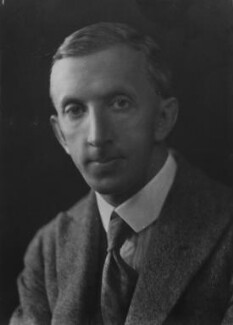Edward Philip Stibbe
Contents
Notes
Office Notes
House Notes
1927.10.25 proposed by G. Elliot Smith, seconded by H.J.E. Peake
Notes From Elsewhere
Born 12 November 1884 at Glasgow, eldest child of Godfrey Stibbe, hosiery machine builder, and Sophia Dennis, his wife. He was educated at Allan Grant's School, Glasgow, and at Wyggeston School, Leicester, before entering Charing Cross Hospital Medical School. After qualifying in 1908 he entered the Government Medical Service in Fiji in 1909; in 1912 he became district medical officer of Vosburg in South Africa, and interested himself in measuring native skulls. During the first world war he served as medical officer at the 1st Northern General Hospital at Newcastle-upon-Tyne, 1915-18. He went back to South Africa in 1919 as professor of anatomy at the University of South Africa, Pretoria.
He took the Fellowship in 1925, and began to teach anatomy in this country, being successively demonstrator at Durham and Liverpool Universities and senior demonstrator at University College, London, and at the London Hospital under William Wright. In 1935 he joined the staff of King's College in the Strand, and was appointed University of London reader of anatomy; three years later, 1938, he was elected professor. At King's he filled the offices of sub-dean and tutor in the Medical Faculty. He was a wise and generous friend of his pupils, and served the College well in the difficult years of evacuation, 1939-42. At the Royal College of Surgeons Stibbe was a Hunterian professor in 1936, lecturing on the surgical anatomy of the sub-tentorial angle, and he examined for the Conjoint Board 1933-38 and for the Fellowship 1936-41. He was elected to examine for the Fellowship overseas in 1939-40, but the war postponed these examinations. He also examined for Durham and Liverpool Universities and for the Society of Apothecaries.
Stibbe was a member of council of the Anatomical Society of Great Britain and Ireland, and a Fellow of the Royal Anthropological Institute. He edited in 1932 a Practical anatomy, by six teachers; William Wright, T E Yeates, J S B Stopford, S E Whitnall, M F Lucas Keene, and himself. In 1930 he wrote a Textbook of physical anthropology, which reached a second edition in 1938. Stibbe married (1) in 1909 Celia Evelyn Rail, and there were two sons and a daughter of the marriage; (2) in 1924 Florence Kate Roy, who survived him, dying on 5 June 1949. He died on 23 July 1943 at Hardby, Gerrards Cross, Bucks, aged 58, and was buried in St James's churchyard, Gerrards Cross.
Early in the l880s two men were born in Scotland, within some 4 years of each other: one, Robert Black Thomson, in Thomhill, Dumfries, the other, Edward Philip Stibbe, scarcely 100 km away in Glasgow. Both became medical students,
Thomson graduating from Edinburgh in 1905, Stibbe from Charing Cross Hospital Medical School in 1908. Both arrived in South Africa before the Great War, one in 1911 and the other in 1912. They became the first professors of anatomy at, respectively, the fust two medical schools in South Africa, in Cape Town and Johannesburg. Each had a short-lived career in that capacity, Thomson's lasting for 5 effective years, Stibbe's for 3. Each of these two anatomists were much loved by their students. Both men saw service in World War 1. Both occasioned their respective universities some problems, in one instance related to ill health, in the other to an alleged extramarital
relationship that was considered to be scandalous
Hence both men resigned prematurely: Thomson took to medical practice and farming; Stibbe returned to the UK and a career in anatomy. Both were plagued by protracted illnesses that curtailed their lives: Thomson died at 57 years of age, Stibbe at 58 years.
Such, in brief, were the astonishing parallels between the lives of Robert Black Thomson and Edward Philip Stibbe.
The former, Thomson, set the wheels of anatomy in motion at the South African College, later the University of Cape Town. The second, Stibbe, fulfilled a similar role at the South African School of Mines and Technology, which subsequently (1920) became the University College, Johannesburg and, from 1922, the University of the Witwatersrand. In passing, this is the only instance known to me of a medical school being established in a school of mines! In the 8 years of service furnished by the two men, they initiated and ushered into being the fust two departments of human anatomy in the entire continent of Africa outside Egypt. For their pioneering gifts to medical science in this subcontinent, the Anatomical Society of Southern Africa has fittingly established an annual eponymous lecture, to be named, in recognition of their historical roles, the Thomson-Stibbe Lecture. The order of the two names in the title is deliberate, although it reverses the alphabetical sequence, since Thomson's
contribution preceded by some 8 years that of Stibbe. [P.V. Tobias in SAMJ vol. 78 15 Sep. 1990]
Publications
External Publications
The Accessory Pulmonary Lobe of the Vena Azygos
A Comparative Study of the Nictitating Membrane of Birds and Mammals
AN INTRODUCTION TO PHYSICAL ANTHROPOLOGY.1930
Textbook of physical anthropology. London, 1930; 2nd edition, 1938.
True tracheal diverticulunt. J Anat 1929-30, 64, 62.
Practical anatomy, by six teachers, edited. London, 1932.
Anatomy for dental students, by six teachers, edited. London, 1934.
Some observations on the surgery of trigeminal neuralgia. Brit J Surg 1936-37, 24, 122.
Aids to anatomy. London, 1940.
